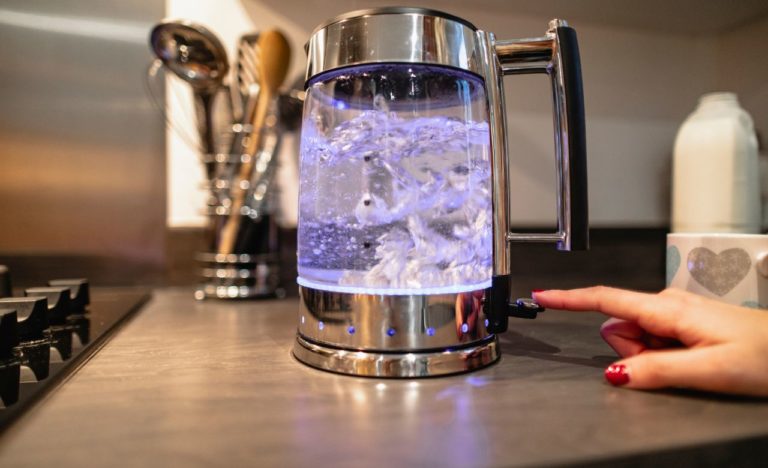ⓘ We are reader-supported and may earn a small commission at no additional cost to you if a purchase is made through one of our links.
To clean an electric kettle, you can use equal parts of water and distilled vinegar, baking soda, or citric acid.
Electric kettles are not only efficient but also versatile. They can help you get the job done within the shortest time possible, thereby lowering your utility costs. The good thing about these units is that they require minimal maintenance.
However, like most appliances, electric kettles require regular cleaning. When used on a daily basis, the inner parts of your kettle are likely to discolour, especially if your area has hard water. The discolouration is a result of mineral build-up that occurs over time.
If not properly cleaned, your kettle will be less efficient, meaning it may take more time to boil your water. As a result, it will use up more electricity than it would when it’s clean.
To avoid this, it is recommended that you clean your kettle after each use. If you are not sure about how you n clean your electric kettle, you are in the right place. We are going to show you various cleaning methods that you can employ when cleaning an electric kettle.
You can click here to have a look at our list of the best electric kettles while at it.
How to Clean an Electric Kettle Using Water and Vinegar
This is probably one of the most commonly used kettle-cleaning techniques. This is primarily because all the items needed are readily available and equally affordable. Besides, almost every Aussie kitchen has a bottle of vinegar.
Additionally, vinegar is very effective when it comes to removing stubborn mineral deposits from kettles. For this method, you will need distilled vinegar, water, and a sponge. Here are 4 simple steps that can help you restore your electric kettle:
Step 1: Add equal amounts of white vinegar and water to your electric kettle until it’s half full
Vinegar is used because it is very acidic and can easily dissolve mineral brine left behind by hard water. On the other hand, water is an excellent solvent, thanks to its ability to readily form hydrogen bonds. As such, the water used in this combo will aid in the breakdown of mineral deposits.
Step 2: Heat the mixture to boiling point
Boiling the mixture will set off a chemical reaction that will speed up the cleaning process. You can unplug your kettle once the mixture has reached its boiling point. Let it sit for about 20-30 minutes so that the vinegar can work its magic.
Step 3: Pour the mixture out
Empty your electric kettle and check if there are any stains left. You can use a sponge to gently scrub off any residual stains. Alternatively, you can repeat steps 1 and 2 until all the brine comes off.
Step 4: Fill the kettle with water and boil
For this step, you will only add water to the kettle. This will help rinse off the vinegar with ease. You can repeat this step until the smell of vinegar goes away. Your electric kettle will be ready for use after the final rinse.
How to Clean an Electric Kettle Using Baking Soda
Like vinegar, baking soda is readily available and is just as reliable as the former. Below are the steps that you can follow:
Step 1: Add 3-4 tablespoons of baking soda and then add water until the kettle is about ¾ full
When mixed with water, baking soda can effectively dissolve stubborn stains, including scale. To get the best results, ensure that the water reaches its boiling point.
Step 2: Let the kettle sit for 15-20 minutes
Allow the solution to dissolve the stains for about 20 minutes, and then drain the kettle.
Step 3: Gently scrub the kettle using a sponge
You can sprinkle a tablespoon of baking soda on a sponge before scrubbing the kettle. Furthermore, the structure of baking soda will provide you with more scrubbing power, allowing for quick and easy removal of stains and scales.
When you are done, rinse the inside of your kettle multiple times before using it.
How to Clean an Electric Kettle Using Citric Acid
Citric acid is also another powerful cleaning agent that you can use. This compound is not only good at removing scale from heating appliances, but also has antibacterial properties.
When used correctly, it will leave your electric kettle clean and germ-free. If you don’t have citric acid in powder form, you can use lemon juice
Without further ado, let us jump straight to the steps:
Step 1: Fill your kettle with water halfway and boil
There are two ways through which you can go about this process. You can start by boiling the water as stated and may as well mix the citric acid with water and then boil it.
Step 2: Add citric acid
Add three to four tablespoons of powdered citric acid. This may however vary when using lemon juice. You can add 2-3 tablespoons of lemon juice.
Step 3: Let it sit
Similar to the previous cleaning methods, you should give the citric solution time for it to work. The waiting time can range between 15 and 30 minutes, depending on the condition that your kettle is in.
Step 4: Empty the kettle and scrub
Lastly, scrub the inner parts of the kettle to remove all the stains. To avoid damaging your kettle, it is advisable that you don’t apply too much pressure to the sponge when scrubbing. In addition to this, you should choose your sponge wisely, since some have extra abrasive surfaces.
Scrub as many times as needed, and repeat steps 1 to 3 if your kettle still has stains. Rinse the kettle with clean water once you are done.
Conclusion
Now that you are familiar with the various methods that can help you clean your kettle, it’s time to do away with those stubborn scales and stains. All the techniques that we have highlighted above are effective and can work on a range of electric kettles, including those made of stainless steel.



